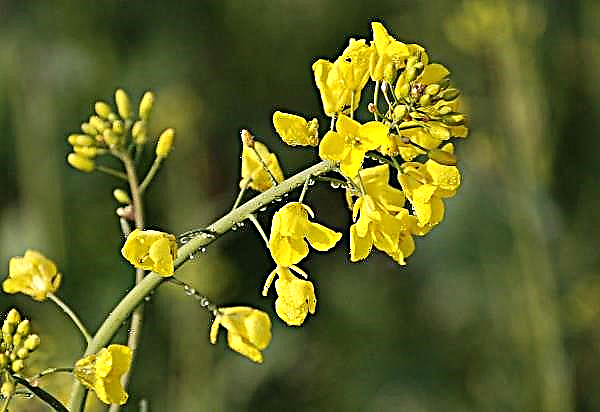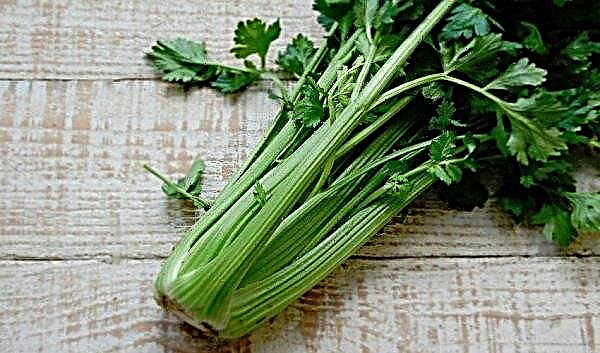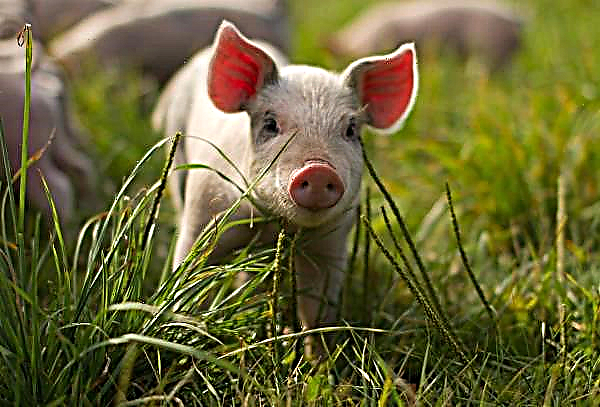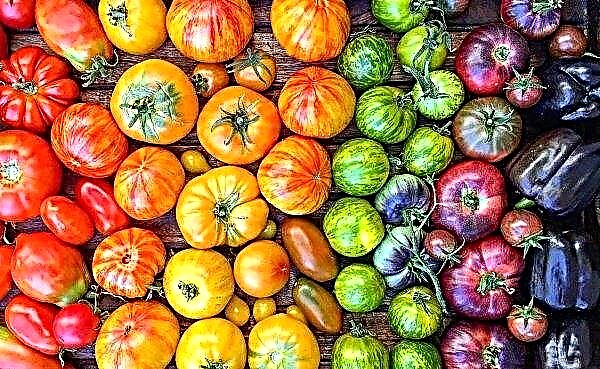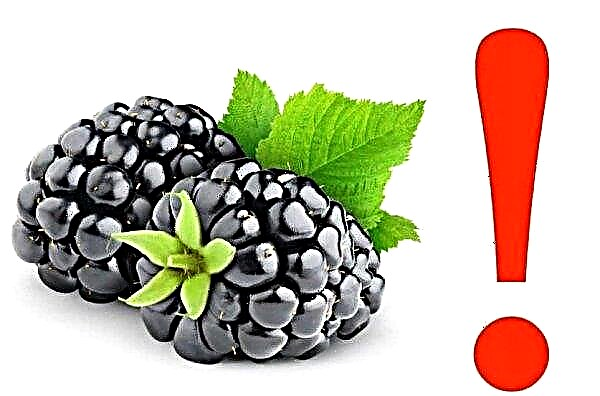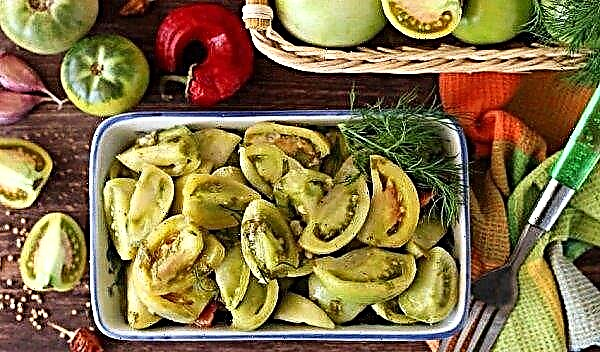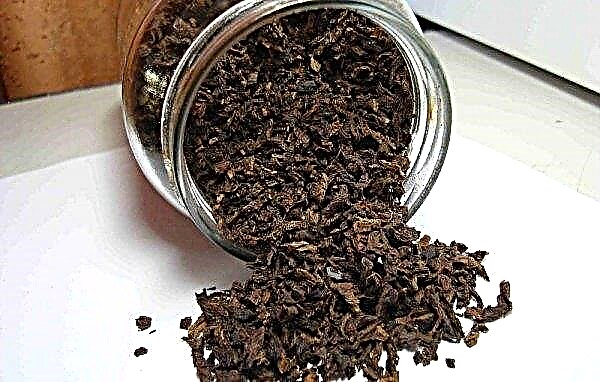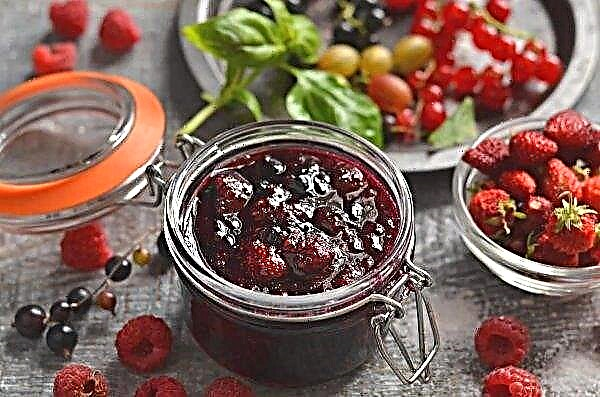Apricots are among the most common fruit trees that can be found on the territory of personal plots and orchards. And this is understandable - a sweet, juicy and fragrant fruit will not leave anyone indifferent. In addition, he has a whole complex of essential vitamins and nutrients that the body so needs in both adults and children. However, a large selection of varieties can lead to a dead end: what apricots can please a plentiful harvest, without requiring much effort. Tsunami variety has a number of advantages that distinguish it from many others. You will learn about them from this article.

The history of the origin of the tsunami apricot
Tsunami Apricots - the fruit of the efforts of the French breeders of the nursery Benoit Escande apricot and belong to the industrial varieties of the new generation of the Escande series. Despite the fact that the variety is new, it has already gained wide popularity not only in the south of Europe (Spain, Italy, France), but also around the world.
Did you know? From the point of view of botany, the closest relatives of apricots are plums.
Variety Characteristics
Tsunami apricots belong to medium-sized varieties, the height of trees of which can reach 4 m. The thick and spreading crown has a rounded shape and hanging branches. Oval-shaped fruits have an impressive weight of 70–90 g. The skin color is bright orange, with a red-carmine hue of ripened sides. The pulp is orange in color, dense and juicy, somewhat fibrous, with a pronounced aroma. The taste is sweet and sour. The fruit bones are medium in size and are well separated from the pulp.
Tsunami - an early ripe variety, its fruits ripen by mid-June and early ripening - the first crop, subject to agronomic measures, can be harvested already in the second or third year of growth.
Drought and frost resistance
The Tsunami apricot variety is unpretentious in care, and therefore tolerates the absence of watering (the exception is the period of fruit formation). Also, this variety compares favorably with high winter hardiness, and therefore, in regions with a temperate climate, it easily tolerates cold and does not require special shelter.
Apricot cultivators
Tsunami is not a self-fertile variety, and therefore requires neighborhood with pollinating treesand. The best varieties for pollination are Goldrich, Tom Cat, Soledane, Pinkot, Silred, Big Red, Spring Blush, as they can increase productivity, but will not have a decisive effect on the pollination of the variety as a whole.
Productivity and fruiting
Tsunami apricots stand out for their high yield, as well as the portability and presentation of the fruits. Being an early-ripening variety, the technical maturity of the Tsunami fruits in the climatic conditions of the middle band begins in mid-June - 10–25.
Apricot Resistance to Diseases and Pests
According to the characteristic, apricots of this variety have a high immunity to fungal diseases that are often found on fruit trees.
Main advantages and disadvantages
- Among the advantages of the variety are:
- high taste characteristics;
- precocity
- good transportability and presentation;
- resistance to various fungal diseases;
- high yields;
- resistance to cold and lack of watering.
Despite so many advantages, Tsunami has virtually no disadvantages. The only thing that can be noted is the need to plant pollinating trees in the neighborhood.
Features of landing at home
Experienced gardeners note that the right choice of seedling and planting location, as well as following the planting technology will guarantee a stable and rich harvest for many years.
Recommended Landing Times
The best time for planting apricots is early spring. - the period when the buds have not yet blossomed on the seedlings. More accurate dates can be determined taking into account the climatic and weather conditions of the region - landing in the second half of March is permissible in the south, while in the middle lane - not earlier than mid-April. The key factor in the choice of time is the air temperature, which should be above 0 ° C not only during the day, but also at night.
The rush to plant a seedling can adversely affect the plant in case of frost return. But delayed deadlines are also not an option - a young tree will be long and difficult to take root due to the active influence of sunlight.
- When planting plants in spring, gardeners get the following benefits:
- before the onset of autumn frosts, the plant manages to develop a strong root system, which makes it easy to tolerate cold;
- it is possible to timely eliminate negative impact factors (diseases, pests);
- time reserve for the preparation of the landing pit and subsidence of the soil.
- Among the shortcomings of this period, there is only a small period of time that goes after frosts and before buds open - it's hard to catch it.
There is also the possibility of planting apricots in the autumn. This method is used in the southern regions, but it is also acceptable for varieties that have high winter hardiness.
- The advantages of autumn planting are:
- a wide selection of planting material at affordable prices;
- the natural moisture of the soil after planting, which the seedlings need.
- Among the shortcomings, the possibility of damage to unstable young trees by natural factors is noted:
- strong winds
- frosts, snowfalls,
- attack of rodents.
Did you know? Apricot was introduced into Europe by Alexander the Great.
Choosing the right place to land
When choosing a landing site, it should be noted that the fruit tree should receive enough light and heat, and also be reliably protected from wind and drafts - these are the factors that contribute to the formation of a large and spreading crown. The most suitable place will be a small elevation or a hill, which will exclude the close passage of groundwater. The west or southwest side will also be preferred.
The soil on the site should be light, loamy or sandy, with neutral acidity, in which chernozem and minerals should be present in sufficient quantities.
However, in the absence of such soil, its structure can be improved by fertilizing:
- clay soils are mixed with peat and coarse sand (in the proportions of 1: 1: 1);
- in sandy soil, the moisture level should be increased, and therefore, a clay layer (about 20 cm) is laid at the bottom of the planting pit, and a layer of deadwood or brushwood on top.
Selection and preparation of planting material
When starting to choose a suitable seedling, you should pay attention, first of all, to its age - one-, two-year-olds are optimal. Experts advise resorting to the services of nurseries, which are located in regions with the same climatic and weather conditions - seedlings grown in the southern regions, as a rule, have a lower winter hardiness.
Other features:
- Sapling grafting - on young trees there are no thorns, but there are small stumps (the place where the rootstock is cut). The absence of such traits may indicate that you have a seedling in front of which there may be no varietal traits.
- Root system - It should be thick and branched, without damage and signs of rot. The place of the cut on the hemp of the seedling should be protracted, since an open wound is a vulnerable place for diseases.
- Elevated part of the seedling - any height is allowed, the main thing is that there should be no visible damage, defects, cracks on the lower part of the trunk (0.5 m) from the root. Also a good indicator is the presence of a large number of living kidneys.

After the acquisition of seedlings, they must be protected from injury during transportation. Young plants react negatively to changes in temperature and humidity, and therefore they wrap the root system during transportation with wet gauze or a cotton cloth, cover it with a plastic wrap and fix it well. After delivery, seedlings should not be immediately deployed - it is better to leave them in this position for several days. 2-3 days before planting, the seedlings are unpacked and placed for a day in a container of water at room temperature (preferably rain). It is also recommended to add growth stimulants to the water, according to the instructions.
Important! Experienced gardeners recommend paraffin dousing the surface of the stem before planting — this protects the trunk from pests, rodents and sunlight.
If the seedling was purchased in the autumn, and the planting itself is scheduled for spring, the young tree must be protected from the cold and the invasion of rodents. To do this, you can use one of the methods:
- Depending on the number of seedlings and the size of their rhizomes, they select a container that is filled with wet sand - trees are planted in such a container (planting depth - about 50 cm). Next, the container is placed in a cool room (cellar) with a temperature of 0 ...– 5 ° C.
- If there is no cellar, you can dig the seedlings. To do this, dig a shallow trench 40-50 cm deep, the southern side of which is given an inclination angle of 50 °. Seedlings are laid in such a way that their crown is directed south, the rhizomes are covered with moist soil, compacted well and watered well again from above. On top lay a spruce branch, which will serve as protection against rodents and winter frosts. After falling snow, it should be picked up for digging, for additional warming.


Step-by-step landing technology
A landing pit for a tree is being prepared in the fall - this approach allows the earth to sag and evenly moisten. Its dimensions are 80 × 80 × 80 cm. At the stage of preparation, the soil from the pit is mixed with humus (30–40 kg), simple superphosphate (about 600 g), potassium sulfate (200–300 g), and ash (2 kg) .
Further, the process consists of several stages:
- The bottom of the pit is laid out with broken brick, gravel or pebbles, which will serve as drainage.
- At the bottom of the landing pit, a peg is driven in, which will support the seedling, and the prepared mixture is poured out of the soil and fertilizers, until a small mound is formed.
- The seedling is carefully inspected for damage that must be removed. If the root has dried out a little, before planting it is dipped for several hours in water at room temperature.
- Immersion of the root neck in the soil is considered unacceptable - the distance from the earth's surface should be at least 5-6 cm.
- The seedling is gently shaken, which makes it possible to spread the roots, and then put on the prepared mound. While holding the seedling, you should sprinkle the roots a little with soil and water the plant with 1 bucket of water, then the rhizome will be completely covered.
- The young tree is firmly tied to the peg, and around the trunk circle form.
- Once again, the seedlings are watered with 10 liters of water, and after complete absorption, the soil of the trunk circle is mulched with sawdust.
Important! Before planting, the seedling root is recommended to be lowered into the solution from manure, which will provide it with additional nutrition.
Apricot Care Rules
As well as planting rules, a clear adherence to agrotechnical measures is important for the growth and healthy development of the tree. Performing simple procedures, you can achieve a quick and rich harvest.
Watering
At different stages of growth and development, watering the tree may vary somewhat:
- Young seedlings for which the soil is not completely compacted is recommended to be watered with small portions of water: first the first portion, then the next - and so on until the soil is saturated with moisture to the depth of the roots (usually 10–20 L of water is required). The frequency of watering depends on weather conditions. In warm weather, watering is carried out weekly, during the heat - more often. It should be borne in mind that in the first year of a plant’s life, it is better to introduce water using a watering can or sprinkler.
- In the second year of growth, apricots are watered less often. The first time - during the flowering period, then - as the soil dries. But frequent watering negatively affects the health of the plant and can lead to decay of the roots. In this case, the soil of the near-stem circle is neatly loosened (the depth should not exceed 10 cm) - this increases air access and promotes drying.
- Further, adult trees are watered several times a year.: the first time during the active growth of shoots (in April), the second time during or after flowering, the third during the formation of fruits. Autumn watering is also carried out, which will provide less freezing of the soil and increase the winter hardiness of the plant. The volume of moisture is used much more - about 60 liters per 1 m².

Watering can be done in several ways:
- furrowed - along the rows of trees form deep trenches where water is poured from a hose or bucket;
- hole - around each trunk they form their own hole, the depth of which depends on the age of the tree (the older, the deeper), where water is poured during irrigation;
- drip - for this method, use plastic or metal pipes with holes made where water enters (by gravity or under pressure);
- inlet - flood the entire area of the garden.
Important! When forming holes, loosening or digging, it should be taken into account that the root system of apricots lies close to the surface of the earth, and it is easy to damage it.
Top dressing
Feeding is one of the most important care procedures - such events give the tree the opportunity to grow intensively and bear fruit abundantly.
Throughout the year, apricots need three top dressings:
- In the spring - the soil is fertilized several times (during and after flowering) using nitrogen-containing fertilizers (150-200 g of urea, 300-400 g of superphosphate, 100-120 g of potassium sulfate), as well as organics (chicken droppings or slurry).
- In summer - at the beginning of summer, foliar top dressing with nitrogen-containing fertilizers is carried out, in the middle of summer - with complex, and at the end - with organic.
- Fall - in the process of preparing the tree for winter, mineral fertilizers (potassium, phosphorus and calcium) are applied to the soil.

Cropping and shaping the crown
The procedure for pruning fruit trees is carried out three times a year and has the following objectives:
- In the spring - pruning is carried out before the swelling of the kidneys and the beginning of sap flow. The main goal is the formation of the crown.
- In summer - carried out between the end of flowering and the beginning of fruiting. The goal is the removal of young shoots that thicken the crown, as well as all sick, damaged and broken branches.
- Fall - carried out after the leaves fall. In order to winter with the least losses, all dry, spoiled and weakened branches are removed.

There is also winter pruning, but most fruit trees react negatively to any intervention in the crown in the cold season. An exception can only be the rejuvenation, which is necessary for adult plants with low yields and chopped fruits.
Important! Places of cuts are best treated with garden varieties, which contribute to early overgrowing.
There are a large number of pruning methods, however, for apricot the most acceptable are:
- Crown formation- in which they shorten the length of the tree and form a crown in the form of a bush. On the plant, 3-4 main branches are formed, without a central conductor. Annual seedlings are shortened by 3-4 buds, and then, every year, they select 3-4 main shoots located evenly around the trunk - they let out 7-8 branches (on the periphery of the crown).This method allows to achieve complete and uniform illumination of the whole tree, which favorably affects the quality of the crop.
- Sparse-tiered formation - on a tree, choose 5–6 main branches located at a distance of 30–40 cm from each other. Branches located 1 m from the ground are shortened by half, leaving a distance between the main branches and the central conductor of 20–25 cm. In the summer, all branches that form an acute angle relative to the trunk are removed. The next year, the formation of the second tier is carried out according to the same principle. This method can significantly accelerate fruiting and improve its quality.


Cold preparation
In the autumn, after pruning, the tree is treated with a 3% solution of Bordeaux fluid as a prophylaxis of fungal diseases. In addition, protecting the trunk from diseases and pests, it is whitened using slaked lime with the addition of mullein.
Despite the high winter hardiness of the Tsunami variety, it is recommended to shelter a fruit tree that does not grow in the southern regions for the winter. To do this, the root system of the plant is insulated - the soil of the trunk circle is covered with peat and humus, and the trunk, along with the root neck, is wrapped with several layers of burlap, after which it is well fixed.
If apricot grows in regions with an unstable climate, warming is carried out more intensively. The height of the tree is shortened to 2–2.5 m, and a frame made of wire or wood is installed around the trunk, or stakes are hammered around the perimeter (4–6 pcs.). From the top to the ground, the plant is wrapped with any breathable material (often used agrofibre), which is fixed below to the stakes or frame. For greater stability, the covering material is sprinkled with earth.
Video: how to prepare young dereko for winter
Grade Diseases and Pests
Tsunami variety has a strong immunity to fungal diseases, which, however, does not give a 100% guarantee, therefore, every gardener must know the signs of possible diseases, as well as methods of treatment and prevention:
- Gum detection - is a signal of inappropriate conditions of detention. To eliminate the gum, it is carefully removed, and the place itself is cleaned and treated with a 1% solution of copper sulfate.
- Bacterial necrosis - It affects all areas of the tree and manifests itself in the form of burns. Then they transform into ulcers, from which gum flows. The bark acquires a brown hue, and the absence of treatment can lead to the death of the plant. To combat the disease, all affected fragments are removed from the tree, and the sections are treated with 1% copper sulphate, and then with garden var. As a preventive measure, the tree is treated with a 1% solution of Bordeaux fluid in the spring and summer, as well as with a 3% solution in the fall, during the fall of the foliage.
- Perforated spotting (kleasterosporiasis) - refers to the most common ailments of fruit trees and affects both individual fragments and the entire plant and has the appearance of small (up to 5 mm in diameter) brown spots - foci of fungal infection. Within a few days, the spots dry and crumble, destroying and leading to the death of the foliage. Also, one of the manifestations may be the formation of dark red spots on the berries, which subsequently leads to their drying out. At the first signs of disease, the foliage is removed from the tree, and the plant itself is treated with Bordeaux liquid according to the scheme 2 times every 10 days.
- Fruit rot (moniliosis) - at the initial stage it appears as small spots, but in a few days it can lead to blackening of the entire fetus and its drying out. During treatment, all affected apricots are removed, and the tree itself is treated with fungicides.
- Cytosporosis - A fungal disease that affects the bark of a tree, giving it a dark brown hue. Signs are wilting and drying of the tops of shoots, as well as brown and brown spots and smudges over the entire surface of the trunk. All diseased fragments are removed from the tree. Prevention of this disease is the systematic pruning, watering and treatment of wounds. Also used as treatment is the treatment with Bordeaux liquid, which is carried out in the first decade of spring (before foliage) and in the autumn, after falling of foliage.
- Aphid - pests that feed on the juice of young shoots and leaves, which leads to their destruction. As a treatment, pesticide treatment is used. If you want to avoid chemical treatment, folk remedies are often used, for example, soap and tobacco infusion.
- Moth - eats young shoots, which leads to their drying and death. Ovaries and unformed fruit bones are also destroyed. In addition, the codling moth is a carrier of many fungal diseases. Pest control is carried out by treatment with insecticides with a frequency of 15 days, 3 times for 1 season.
- Leaflet - butterflies whose caterpillars feed on buds and leaves of trees. As a struggle, insecticidal treatment is used, as well as alternative methods - for example, a solution of laundry soap.








Features of harvesting and storage rules
Taking into account the thin and delicate skin of the fruits, they can be collected only by hand for storage, carefully separating them from the stem and folding them into plastic boxes.
The shelf life of apricots depends on their degree of maturity: completely ripe fruits can be stored for no more than a few days at room temperature. But you can achieve longer storage. For this, each fruit is wrapped in tissue paper, and the crop itself should be stored in a room with a temperature regime of +10 ... + 15 ° С and a humidity indicator of 50–70%. In such conditions, the crop can be stored for up to three weeks.
In the refrigerator, at a temperature of about 0 ° C, fully ripened apricots can retain their taste and appearance for more than 4 weeks. For long-term storage use freezers.
For long-term storage use freezers.
The high taste characteristics of the Tsunami apricot variety, their absolute unpretentiousness and high winter hardiness are deservedly appreciated by summer residents from different regions. Due to the abundant and high-quality crop, even with minimal effort, this variety is widely popular among experienced gardeners, but also among beginners of this business.


